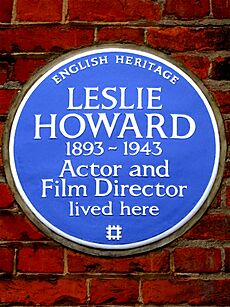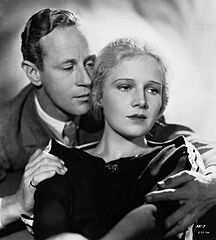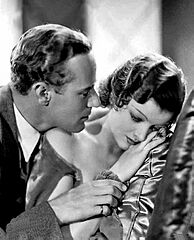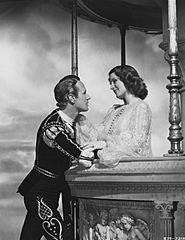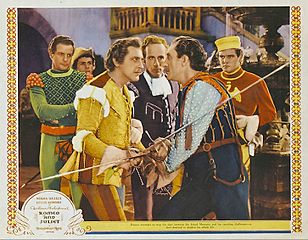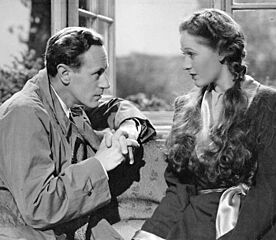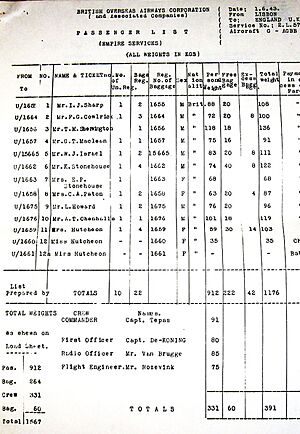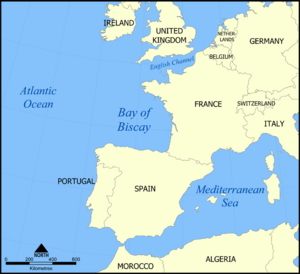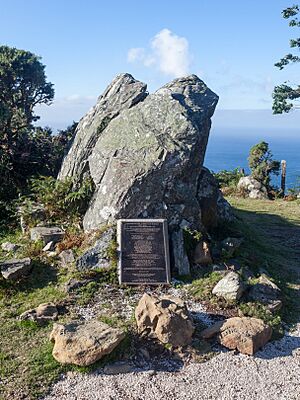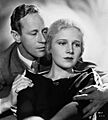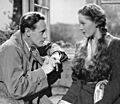Leslie Howard facts for kids
Quick facts for kids
Leslie Howard
|
|
|---|---|
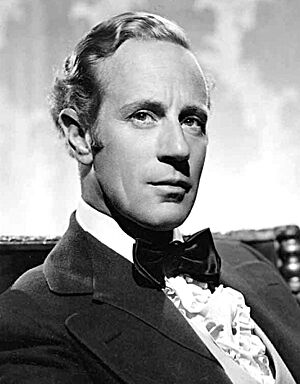
Howard as Ashley Wilkes in Gone with the Wind, 1939
|
|
| Born |
Leslie Howard Steiner
3 April 1893 Forest Hill, London, England
|
| Died | 1 June 1943 (aged 50) At sea off the coast of Galicia, Spain, near Cedeira
|
| Cause of death | Aircraft shot down |
| Occupation |
|
| Years active | 1913–1943 |
| Known for |
|
| Spouse(s) |
Ruth Evelyn Martin
(m. 1916) |
| Children | 2, including Ronald |
Leslie Howard Steiner (born April 3, 1893 – died June 1, 1943) was a talented English actor, director, producer, and writer. He wrote many articles for famous magazines like The New York Times and Vanity Fair. In the 1930s, he was one of the most popular movie stars.
Howard worked in both Britain and Hollywood. He is well-known for playing Ashley Wilkes in Gone with the Wind (1939). He often played the role of a classic English gentleman in his films. Some of his other notable movies include The Scarlet Pimpernel (1934) and Pygmalion (1938). He was nominated for an Academy Award for Best Actor twice.
During World War II, Howard used his acting and filmmaking skills to help his country. He created films that supported the Allies and were against Germany. After his death, his work was called "one of the most valuable parts of British propaganda." There were rumors that he was involved with British intelligence. This led to theories about his death in 1943 when his plane, BOAC Flight 777, was shot down by the Luftwaffe over the Atlantic Ocean.
Contents
Leslie Howard's Early Life
Leslie Howard Steiner was born in Forest Hill, London. His mother, Lilian, was British, and his father, Ferdinand Steiner, was a Hungarian Jewish immigrant. Leslie's younger brother, Arthur Howard, also became an actor.
He went to Alleyn's School in London. Around the time of the First World War, his family changed their last name to "Stainer." However, Leslie's official documents, like his military records, still showed his name as Steiner.
When World War I started, Howard was 21 and worked as a bank clerk. In September 1914, he joined the British Army. He trained in England until May 1916. He then left the army due to health reasons.
In March 1920, Howard officially changed his last name to Howard instead of Steiner.
Acting on Stage
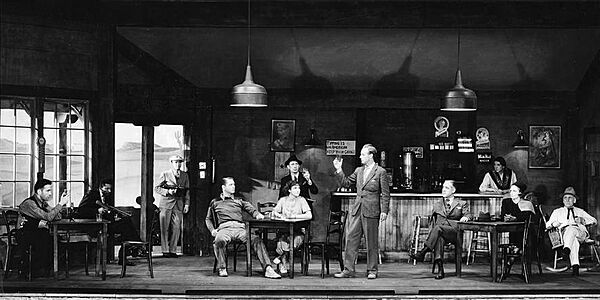
Howard started his acting career in 1916. He performed in plays that toured different regions of England. He also appeared on the London stage in 1917. His biggest success in theater came in the United States on Broadway theatre.
He starred in popular plays like Aren't We All? (1923) and The Green Hat (1925). He became a major Broadway star with Her Cardboard Lover (1927). After playing a time traveller in Berkeley Square (1929), he started his Hollywood career. He first appeared in the film version of Outward Bound.
Even after becoming a movie star, the stage remained important to him. Howard often acted, produced, and directed plays on Broadway. He was also a playwright and starred in his own play, Murray Hill (1927). His stage successes continued with The Animal Kingdom (1932) and The Petrified Forest (1934). He later played these roles in the movie versions too.
Howard loved performing Shakespeare's plays. He became famous for his role in Romeo and Juliet (1936). He was also part of the American Theatre Hall of Fame in 1981.
Movies and Fame
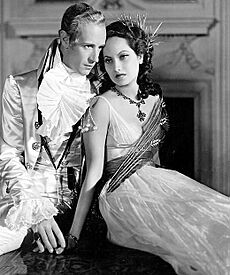
In 1920, Leslie Howard and his friend Adrian Brunel started a film company called Minerva Films Ltd. The company produced films written by A. A. Milne, who created Winnie-the-Pooh. Although the films were liked by critics, the company didn't make much money and closed down.
In both British and Hollywood movies, Howard often played calm and proper English characters. He appeared in the film Outward Bound (1930). He also had a big role alongside Norma Shearer in A Free Soul (1931). This movie also featured Clark Gable, who would later star with Howard in Gone with the Wind.
Howard was nominated for an Academy Award for Best Actor for his role in Berkeley Square (1933). He played the main character in The Scarlet Pimpernel (1934). Many people consider his portrayal to be the best.
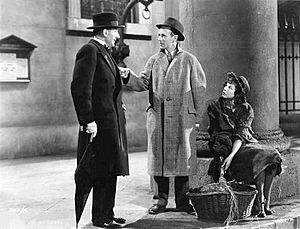
When Howard starred with Bette Davis in The Petrified Forest (1936), he insisted that Humphrey Bogart play the gangster Duke Mantee. This helped restart Bogart's movie career, and they became close friends. Bogart and Lauren Bacall later named their daughter "Leslie Howard Bogart" after him. In the same year, Howard starred with Norma Shearer in a film version of Shakespeare's Romeo and Juliet (1936).
Bette Davis was again his co-star in the romantic comedy It's Love I'm After (1937). He played Professor Henry Higgins in the film Pygmalion (1938), earning him another Academy Award nomination. In 1939, as war neared, he starred with Ingrid Bergman in Intermezzo.
Howard is perhaps most famous for his role as Ashley Wilkes in Gone with the Wind (1939). This was his last American film. He felt uncomfortable in Hollywood and returned to Britain to help with the World War II effort. He starred in several war films, including "Pimpernel" Smith (1941) and The First of the Few (1942). He also directed and co-produced these two films.
After his death, British movie theaters voted him the second most popular local star in 1944. His daughter described him as a "remarkable man."
-
Howard and Ann Harding in The Animal Kingdom (1932)
-
Howard and Myrna Loy in The Animal Kingdom (1932)
-
Howard and Norma Shearer in Romeo and Juliet (1936)
-
Romeo and Juliet (1936) lobby card with John Barrymore and Basil Rathbone
His Family Life
Leslie Howard married Ruth Evelyn Martin in March 1916. They had two children: Ronald "Winkie" (1918–1996) and Leslie Ruth "Doodie" (1924–2013). His daughter Leslie Ruth appeared with him in the film The First of the Few (1942). She also contributed to a film about her father called Leslie Howard: The Man Who cared.
His son, Ronald Howard, became an actor. He played the famous detective Sherlock Holmes in a 1954 TV series. Leslie's younger brother, Arthur Howard, was also an actor, known for British comedies. His sister Irene Howard was a costume designer and casting director for Metro-Goldwyn-Mayer. Another sister, Doris Stainer, founded a school in Berkshire in 1945.
The Howard family lived in a 16th-century farmhouse called Stowe Maries in Britain. In 2013, an English Heritage blue plaque was placed at his former home in London.
Leslie Howard on Radio
Howard was also a talented radio actor. He started his radio career in the early 1930s. He performed dramatic readings for a show called The Yardley Program. He was also a guest on popular shows like Lux Radio Theatre and Kraft Music Hall with Bing Crosby.
In May 1935, Leslie Howard and his 10-year-old daughter, Leslie Ruth, appeared on The Rudy Vallee Show. They performed a scene from a play called Dear Brutus. The audience loved it so much that they were asked to perform it again.
Howard also had his own show on CBS from 1935 to 1936. It was a serial called The Amateur Gentleman. Later, it became Leslie Howard's Matinee, where he adapted popular plays for radio listeners. He also produced two shows for Lux Radio Theatre.
His last known radio appearance in the United States was a tribute to the King and Queen of England. After World War II began, Howard made many broadcasts for the BBC's Britain Speaks. These broadcasts were sent to the United States, encouraging America to join the war and support Britain.
Unfortunately, many of Howard's radio broadcasts have been lost over time. However, some have survived for people to enjoy today.
A Tragic End: His Death
In May 1943, Howard traveled to Portugal to promote the British cause. On June 1, 1943, he was on KLM Royal Dutch Airlines/BOAC Flight 777. This was a Douglas DC-3 plane flying from Lisbon to Bristol. The plane was shot down by Luftwaffe fighter planes over the Atlantic Ocean. Howard was one of 17 people who died, including four KLM flight crew members.
The BOAC DC-3 plane had been flying this route regularly since 1942. This area was not usually considered a war zone. However, by 1942, the Germans saw it as a "very sensitive war zone." The same plane had been attacked twice before by German fighters, but the pilots managed to escape.
On June 1, 1943, the DC-3 was attacked by eight German Ju 88 C-6 fighter planes. The plane's last radio message said it was being fired upon. German documents state the plane was shot down about 500 miles (800 km) from Bordeaux, France. A German pilot involved said his squadron shot down the plane because they thought it was an enemy aircraft. He also said they were angry that their leaders hadn't told them about scheduled civilian flights. If they had known, they could have captured the plane and everyone on board. The German pilots even photographed the wreckage in the Bay of Biscay. Copies of these photos were later sent to Howard's family.
The day after the attack, a British flying boat searched the area. It was also attacked by eight German planes. After a fierce battle, the British plane shot down three attackers before crash-landing. After these events, all BOAC flights from Lisbon were changed to fly only at night.
The news of Howard's death was published in the same newspaper issue that reported the "death" of "Major William Martin." This was a fake person created for a famous deception called Operation Mincemeat.
Why Was His Plane Shot Down?
One idea, which is not fully supported, suggests that the Germans thought British Prime Minister Winston Churchill was on the flight. Churchill himself wrote that German agents might have mistaken Howard's agent, who was a "thickset man smoking a cigar," for him. Churchill said the German actions were brutal and their agents were foolish.
However, two books about the flight argue that Howard was the actual target. These books, Flight 777 (1957) and In Search of My Father: A Portrait of Leslie Howard (1984) by his son Ronald Howard, claim the Germans deliberately shot down the plane to lower British morale. Howard had been traveling through Spain and Portugal, giving talks about film. He was also meeting with people to gain support for the Allies. The British Film Yearbook for 1945 called Howard's work "one of the most valuable parts of British propaganda."
The Germans might have suspected Howard was involved in secret activities. Portugal was a place where spies from both sides met. Ronald Howard's book suggests that the order to shoot down the plane came directly from Joseph Goebbels. Goebbels was the Nazi Minister of Propaganda. He believed Howard was a very dangerous British propagandist.
Most of the other passengers were British businessmen or government workers. There were also a few children of British military personnel. Two teenage boys, George and William Cecil, were taken off the flight at the last minute. This saved their lives.
A 2008 book by Spanish writer José Rey Ximena suggests Howard was on a secret mission for Churchill. The goal was to convince Spanish dictator Francisco Franco not to join the Axis powers.
Some theories suggest that the British knew about the German plan to shoot down the plane. They might have allowed it to happen to protect the secret that they had broken the German Enigma code. However, a recently revealed recording of a German pilot involved in the attack suggests otherwise. The pilot said he knew nothing about the passengers' identities or importance until he heard an English radio broadcast later that evening. He stated that they shot down "Whatever crossed our path."
A 2010 biography by Estel Eforgan, Leslie Howard: The Lost Actor, looked at new evidence. It concluded that Howard was not a specific target. It supported the German statements that the shootdown was "an error in judgment."
There is a monument in San Andrés de Teixido, Spain, dedicated to the victims of the crash. Howard's plane was shot down over the sea north of this village.
The Mystery of Flight 777
The Mystery of Flight 777 is a documentary film by Thomas Hamilton. It explores the events, theories, and myths surrounding the shooting down of Howard's plane. The film also looks closely at some of the other passengers on board. This project grew bigger than planned and is still being worked on as of January 2021.
Books About Leslie Howard
Leslie Howard died too soon to write his own life story. His son Ronald edited a collection of his writings called Trivial Fond Records, published in 1982. This book shares details about his family life and his thoughts on America and democracy during World War II.
Both his son and daughter wrote books about their father. Ronald Howard wrote In Search of My Father: A Portrait of Leslie Howard (1984). His daughter, Leslie Ruth Howard, wrote A Quite Remarkable Father: A Biography of Leslie Howard (1959).
Estel Eforgan's Leslie Howard: The Lost Actor is a full biography published in 2010.
The Documentary: "The Man Who Cared"
Leslie Howard: The Man Who cared is a documentary film about his life. It was first shown privately in 2009. After some changes and rights negotiations, it was officially launched in September 2011.
The film was re-edited between 2014 and 2015. It included new material like old interviews and historical footage. This new version won the Best Documentary Film award at the San Francisco Mostly British Film Festival in 2015.
Leslie Howard: The Man Who cared was first broadcast on TV in the UK in December 2017. It then premiered in the US on Turner Classic Movies in June 2018.
Influence
The famous Hongkongese singer and actor, Leslie Cheung, chose "Leslie" as his first name because he admired Leslie Howard.
Images for kids
-
Howard and Ann Harding in The Animal Kingdom (1932)
-
Howard and Myrna Loy in The Animal Kingdom (1932)
-
Howard and Norma Shearer in Romeo and Juliet (1936)
-
Romeo and Juliet (1936) lobby card with John Barrymore and Basil Rathbone
See also
 In Spanish: Leslie Howard (actor) para niños
In Spanish: Leslie Howard (actor) para niños


